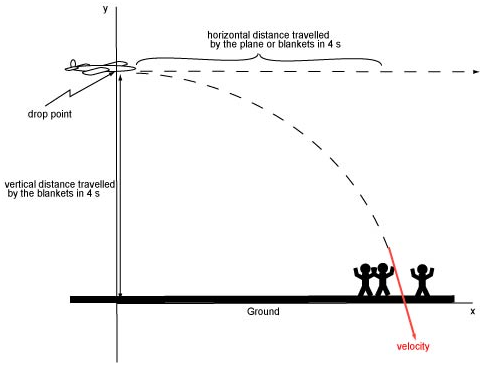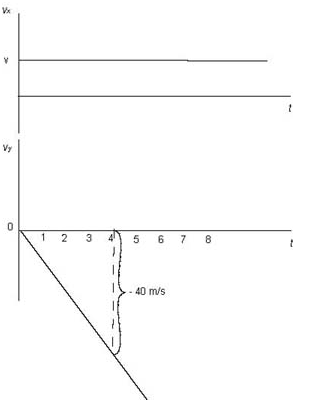Proj Motion EX 8
Helena Dedic
A plane flying horizontally dropped a supply of blankets for stranded hunters. The blankets landed 4 s after the drop with a speed of 50 m/s.
a. What were the components of the velocity when the supply landed?
b. What was the velocity of the plane?
c. How high was the plane flying?
d. How far did the blankets move in the horizontal direction?
Solution:
The plane is flying horizontally with some speed v. The blankets, when dropped, move (initially) with the speed of the plane.
Their initial velocity is therefore horizontal.
Now, let us choose coordinate system with origin on the ground just below the drop point. The positive y-axis points upward and the positive x-axis points in the direction the plane is moving.
This means the y-component of initial velocity is 0 while the x-component is v.
The blankets follow parabolic path, and land 4 s later. Since the y-component of velocity decreases at a rate of - 10 m/s every second we know that the blankets land with vertical component of velocity equal to - 40 m/s. Moreover, we are told the speed of the blankets as they land is 50 m/s. Thus we know the magnitude and y-component of velocity. Consider the following picture:
Thus let us draw - t and - t graphs and use these to solve the given problem:
a. We know the magnitude of velocity is 50 m/s and the y-component is - 40 m/s. We solve for vx using the equation :
It follows that , so the components of velocity at impact is (30, -40) m/s.
b. The velocity of the plane is the same as the horizontal component of the velocity of the blankets i.e., 30 m/s.
c. The vertical distance travelled by the blankets is the area under the triangle: ½ • 4 • (- 40) = - 80 m. The vertical displacement of the blankets is - 80 m so the plane flies at an altitude of 80 m.
d. Since the horizontal velocity of the blankets was 30 m/s we conclude that they covered a horizontal distance of 120 m in 4 s.

